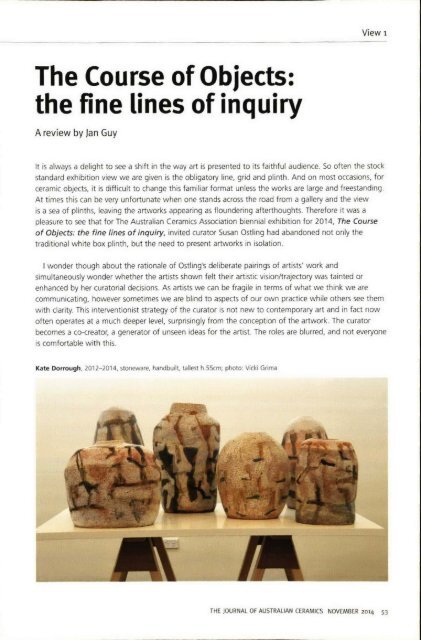The Journal of Australian Ceramics Vol 53 No 3 November 2014
Create successful ePaper yourself
Turn your PDF publications into a flip-book with our unique Google optimized e-Paper software.
View 1<br />
<strong>The</strong> Course <strong>of</strong> Objects:<br />
the fine lines <strong>of</strong> inquiry<br />
A review by Jan Guy<br />
It is always a delight to see a shift in the way art is presented to its faithful audience. So <strong>of</strong>ten the stock<br />
standard exhibition view we are given is the obligatory line, grid and plinth. And on most occasions, for<br />
ceramic objects, it is difficult to change this familiar format unless the works are large and freestanding.<br />
At times this can be very unfortunate when one stands across the road from a gallery and the view<br />
is a sea <strong>of</strong> plinths, leaving the artworks appearing as floundering afterthoughts. <strong>The</strong>refore it was a<br />
pleasure to see that for <strong>The</strong> <strong>Australian</strong> <strong>Ceramics</strong> Association biennial exhibition for <strong>2014</strong>, <strong>The</strong> Course<br />
<strong>of</strong> Objects: the fine lines <strong>of</strong> inquiry, invited curator Susan Ostling had abandoned not only the<br />
traditional white box plinth, but the need to present artworks in isolation.<br />
I wonder though about the rationale <strong>of</strong> Ostling's deliberate pairings <strong>of</strong> artists' work and<br />
simultaneously wonder whether the artists shown felt their artistic visionftrajectory was tainted or<br />
enhanced by her curatorial decisions. As artists we can be fragile in terms <strong>of</strong> what we think we are<br />
communicating, however sometimes we are blind to aspects <strong>of</strong> our own practice while others see them<br />
with clarity. This interventionist strategy <strong>of</strong> the curator is not new to contemporary art and in fact now<br />
<strong>of</strong>ten operates at a much deeper level, surprisingly from the conception <strong>of</strong> the artwork. <strong>The</strong> curator<br />
becomes a co-creator, a generator <strong>of</strong> unseen ideas for the artist. <strong>The</strong> roles are blurred, and not everyone<br />
is comfortable with this.<br />
Kate Dorrough, 2012-<strong>2014</strong>, stoneware, handbuilt, tallest h.SScm; photo: Vicki Grima<br />
THE JOURNAL OF AUSTRALIAN CERAMICS NOVEMBER <strong>2014</strong><br />
S3

















